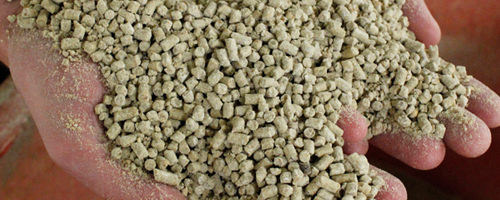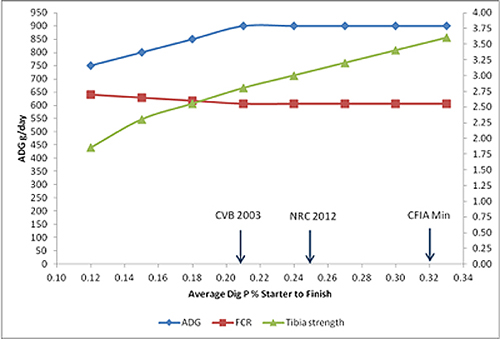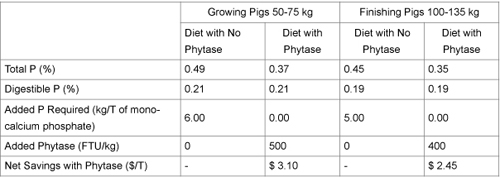By: Dr. Mario Ramirez, Dr. Malachy Young, and Clarence Froese of Gowans Feed Consulting

The management of residual phosphorous (P) in manure and the rising price of inorganic phosphate are becoming major issues for swine producers in some regions. To optimize phosphorous utilization, it is crucial to improve our ability to accurately predict the amount that will be digested by the pig in a given diet as well as the amount that will be excreted. Optimizing pig performance and structural soundness while minimizing production costs and impact on the environment can be complimentary goals in swine feeding operations. Successful strategies to meet this goal include reviewing phosphorous formulation targets, utilizing new tools to improve the accuracy of diet formulations, and using additives to enhance phosphorous digestibility.
Choosing Target Dietary P Levels
Historically, it was assumed that the phosphorous and calcium content of ingredients typically included in swine diets (tankage, meat and bone meal, fish meal) was adequate to supply the required amounts for pigs to grow. When these ingredients were replaced by cereal grains and plant protein sources in the early 1900’s, many symptoms of phosphorous and calcium deficiency such as rickets in young pigs and bone breakage in adult pigs began to appear. Subsequent efforts to define calcium and phosphorous requirements therefore focussed on maximizing bone density and strength to avoid the symptoms of deficiency. Some of the earliest phosphorous recommendations were published in the late 1930’s, and were listed at levels between 0.27 and 0.30% of the diet.
In the early 1960’s researchers first showed that dietary calcium and phosphorus levels required for optimum growth and feed conversion were lower than those needed for bone development. Today, it is well known that the phosphorous level required to support optimum performance is about 0.1 percentage points below that which results in maximum bone strength. Formulators must therefore choose the criteria on which to base target dietary phosphorous levels. In Canada, that choice has been made for the industry by government regulation which stipulates a minimum level of 0.50% total P (approximately 0.32% digestible P) in growing and adult swine diets. As illustrated in Figure 1 (CFIA Min.), this is the level that supports maximum bone strength. Other jurisdictions such as the Netherlands, where manure P content is strictly regulated, recommend dietary P levels much closer to those which support optimum performance (CVB 2003, Figure 1) and minimize P excretion. The Nutrient Requirements of Swine published by the National Research Council, a common reference used by the North American pig industry, recommends a dietary P level midway between these two points (NRC 2012, Figure 1). This recommendation is well above the level for optimum performance but eliminates a significant amount of the surplus phosphorous required to maximize bone strength.
Figure 1. Average response of ADG, FCR and bone strength to increased levels of digestible phosphorous in grow/finish pig diets.

The impact of formulating to dietary P levels which result in maximum bone strength and adhere to the regulatory minimum as specified by the Canadian Food Inspection Agency (CFIA) is illustrated in the following comparison:

Reducing P levels from current CFIA minimums to current NRC recommendations would reduce the amount of inorganic P (Monocalcium phosphate) by 50% in grower diets and eliminate it entirely from finisher diets, saving up to $5.00 per tonne in feed costs. In addition, P excretion rates in manure would be greatly reduced since pigs retain only 40 to 50 % of their daily P intake. Adoption of the guidelines from the Netherlands (CVB, 2003) would result in further savings and reductions in P excretion. The final amount of added inorganic phosphorous will depend on the ingredients used in the diet.
Deciding on which criteria to formulate target P levels for a population of pigs depends largely on the feed intakes being achieved as well as the rearing and handling environment to which they are subjected. If symptoms related to bone weakness become prevalent as lower P diets are fed, then dietary P target levels must be adjusted. However, the Dutch experience coupled with current NRC recommendations would suggest that there is room to lower these targets in typical Western Canadian diets. Formulating to levels below the CFIA minimum is legally possible in Canada by having the diet end user sign off on the formula and wording the accompanying feed label accordingly.
Improving Formulation Accuracy
Early recommendations on phosphorous requirements of pigs were expressed as the total P level in the diet without differentiating the sources providing the P. This approach failed to consider that a significant portion of the total P in typical diets comes from plant sources. Plants store 50 to 90 % of their phosphorous in a complex form (phytate). Monogastric animals such as pigs are unable to utilize phosphorous in this form as they lack the appropriate digestive enzyme (phytase) to liberate the P from the phytate complex. Based on this knowledge, total phosphorus recommendations were elevated to compensate for the unknown availability from dietary plant ingredients, thereby overstating requirements.
As more became known about phytate P, the concept of Available Phosphorus was adopted to more accurately formulate swine diets. Available phosphorus is defined as the difference between the total P and the phytate P, and assumes that all non phytate P is available to the animal. Although more accurate than total P, this concept still forces formulators to employ a large safety margin to compensate for the possibility of non phytate P being less than 100% available. Available P is currently the most common method used in North America to formulate swine diets for phosphorous content.
Most recently the concept of Standardized Total Tract Digestibility (STTD) has been developed for phosphorus and is defined as:
STTD P = Total P – Fecal P + Basal Endogenous P Loss
where fecal P is the amount of excreted phosphorous measured in the feces of animals in an ingredient feeding trial, and basal endogenous P is the amount of P excreted by animals that comes from sources other than feed (digestive juices, intestinal cells, etc.). STTD P values have been determined through feeding trials for most plant and non plant ingredients used in swine diets, giving formulators a much more accurate method of determining the amount of P retained by the pig regardless of the ingredients used. The 2012 Nutrient Requirements of Swine published by NRC contains a complete listing of STTD P values for various swine feedstuffs. These can be integrated into formulation programs to result in more accurate estimations of phosphorous retention, thereby decreasing the margin of safety commonly assigned to dietary P requirements.
Using Microbial Phytase
Phosphorous digestibility from plant sources can be significantly increased by the addition of microbial phytase enzymes which break down the phytate complex and release a significant portion of the otherwise unavailable P. The routine addition of this enzyme to feeds allows the total P level of the diets to be reduced and results in a decrease in phosphorous excretion of 30 to 60%. The following comparison of typical Western Canadian diets with and without phytase illustrates how its inclusion can reduce or eliminate the need for supplemental phosphorous sources in the diet as well as produce a net savings in diet costs:

Several factors can influence the efficacy of phytase, including the amount of phytate in the diet, the amount of phytase added to the diet, and the type of phytase. Consult a qualified nutritionist for detailed recommendations on its use.
Conclusion:
Great strides in technology and our understanding of phosphorous utilization and requirements have been made in the past two decades. The North American pig industry now has the tools to move toward lower phosphorous levels in swine diets and a reduction in phosphorous excretion levels. To embark in this direction, the following steps are necessary:
1. Choose dietary P levels which target maximum performance rather than maximum bone mineralization and strength.
2. Formulate based on standardized total tract digestible phosphorus (STTD P).
3. Utilize well tested phosphorus digestibility values for ingredients, such as those listed in the 2012 edition of the NRC Nutrient Requirements of Swine.
4. Add microbial phytase to diets to reduce or eliminate the amount of inorganic phosphate needed to meet requirements.


